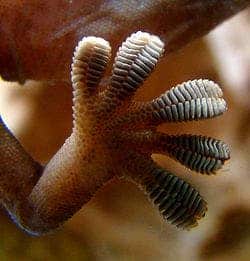
The gecko is one of the most fascinating lizards, because of its feet’s unique ability of dry adherence to solid surfaces allowing it to surmount any geometry and making it an excellent climber in the process. Unlike other animals which employ a liquid or some kind of suction to climb walls, the gecko uses inter-molecular attraction forces known as van der Waals. Scientists have made numerous attempts of mimicking this extremely complex, yet potentially useful, feature. Recently, a demonstration comprised of a tank-like robot that can climb smooth walls with the ease of a gecko on a moon-light night shows that scientists are only a step away from building the perfect escalatting bots.
On its toes, the gecko exhibits specialized pads comprised of various satae (bristle- or hair-like structures ) on the tip of which lie tiny structures called spatulae, each less than a micron wide. These allow attractive forces called van der Waals interactions to arise between the adhesive setae and the surface. A single spatulae shows very weak molecular forces, however when coupled together in thousands of thousands on the satae, the attraction becomes very strong. These forces are so strong that they not only allow for supporting the gecko’s weight, but for even a highly roboust human as well – up to 133 kg can be sustained by the adherence forces between the gecko’s toes and a surface. Impressed yet?
The Canadian scientists of Mechanisms ‘N Robotics for Viable Applications (MENRVA) Lab at Simon Fraser University in Burnaby, British Columbia, were impressed enough to begin a laborious research. The robot team, led by Jeff Krahn at Simon Fraser University in Burnaby, recreated the gecko toe pads by using a material called polydimethysiloxane (PDMS) for the satae, which they made 17 microns across and with ends shaped like mushroom caps. The structured adhered easily enough to a surface, however for the robot to move it had to peel off the attraction forces, otherwise it would get stuck. This is why Krahn and his team put the mushroom-capped setae on tank-like treads.
“While van der Waals forces are considered to be relatively weak, the thin, flexible overhang provided by the mushroom cap ensures that the area of contact between the robot and the surface is maximized,” Krahn explained in a news release.
By using the gecko-like toe pads, the researchers’ robot was able to climb even smooth surfaces such as glass or plastic, materials that are a consistent challenge for robots that use magnets, suction cups, spines and claws to climb. In addition the later various types of robots offer other difficult issues, like gooey trails or special conditions (magnets need metal, claws need something to stick to, suction cups need powerful pumps and so on).
A wet adhesive machine leaves traces of its movement, and usually its main mode of failure is due to it being clogged by dust particles that stick onto these tracing layers.
The tank-like robot, dubbed Timeless Belt Climbing Platform (TBCP-II), weighs in at 240 grams and can transfer from a flat surface to a wall over inside and outside corners. It has a top speed of 3.4 centimeters per second. To detect its surroundings and alter its course to navigate obstacle, the robot has built in sensors, however its makers are now working hard to improve its control strategy to eventually render it fully autonomous.
Mike Murphy, now at Boston Dynamics (the company that brought us The Petman), has done extensive research on dry adhesion in robots. He said the fact that the Simon Fraser team was able to make a tread is something of a first. “Creating a continuous loop of micropatterned adhesive can be a challenge,” he said. “Accomplishing internal and external transitions is a difficult maneuver for any climbing robot, but the reward is significantly improved applicability in real-world environments.”
source


